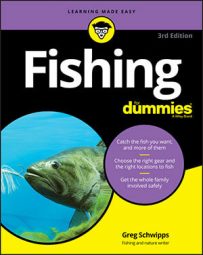Similar to the temperate bass family, the trout family has some odd twists in its family tree, as species can cross-breed and might be anadromous — that is, live part of their lives in both salt- and freshwater. The salmonid family is divided into five groups: trouts, including the Atlantic salmon; Pacific salmon; char; grayling; and whitefish. Fish from the first three groups are represented here, as they’re the most pursued by anglers. Don’t worry — you don’t need to understand that to catch a trout.
Many states, including those far from the original range of certain species of trout, often raise trout in hatcheries and release them in select locations. There may be an additional license or charge to fish for these trout, but they provide anglers a shot at wonderful-tasting fish. Check with your local DNR to see if trout are either native or stocked within your area.
Rainbow trout: High jumpers
The colorful rainbow trout is one of the most sought-after gamefish in the world. Rainbows coexist nicely with brown trout in many streams (see the following section for details on the brown trout). Whereas the brown prefers slower water and calmer pools, you can depend on finding the rainbow in the more oxygen-rich and swift-running riffles. This scenario is what you would expect from a fish that predominates in the mountain streams of the Rocky Mountains.As seen in the color section, the rainbow may have spots over the whole body (although in many rivers and lakes, the larger rainbows are more often an overall silver). A much more reliable sign of “rainbowness” is the pink band or line that runs along the flank of the fish from shoulder to tail. But even this indicator is not always 100 percent foolproof because some stream-borne rainbows have a faded, almost invisible band and many spots, as do the brown and brook trout.
Brown trout: The champ of the stream
The brown trout is a fish designed for the angler. It often feeds on the surface. It rises to a properly presented fly. It fights like the dickens. The brown trout is a cold-water fish that lives in lakes and streams and is most active when the water temperature is in the 60s. A temperature much higher than 80 degrees is liable to kill brown trout. As shown, the brown trout is covered with spots everywhere but its tail. The majority of the spots are deep brown, like coffee beans, with a light yellow halo. Sprinkled around its skin, you also find a few red and yellow spots. Brown trout are long-lived animals and can reach weights up to 40 pounds, but most stream-bred fish average less than a pound each. They say that a few wise browns in every stream usually reach weights of 10 pounds or more.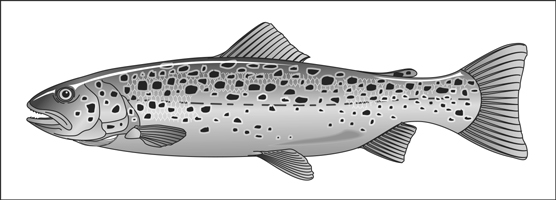 The brown trout is a wily and rewarding fish when taken on rod and reel.
The brown trout is a wily and rewarding fish when taken on rod and reel.Brook trout: Sentimental favorites
The brook trout, or brookie, fills the trout niche in the cooler streams of the northeastern United States, east of the Allegheny Mountains. (They have been introduced elsewhere.) The brook trout is actually a char, which makes it a relative of the lake trout, the Dolly Varden, and the Arctic char.This fish is a sign of pure water and a healthy ecology. Brook trout like cooler water and cannot stand the higher temperatures that the brown and the rainbow can tolerate. Before Europeans cleared the great hardwood forests of the northeastern United States, most streams had the shade and pure water that brook trout need.
The brook trout has many red spots that are surrounded by a blue halo. The fins have a telltale black and white tip. The belly and fins have an orange cast that can be quite brilliant and almost crimson in spawning season. The tail of the brook trout is more squared off than that of the brown and rainbow, hence the nickname squaretail.
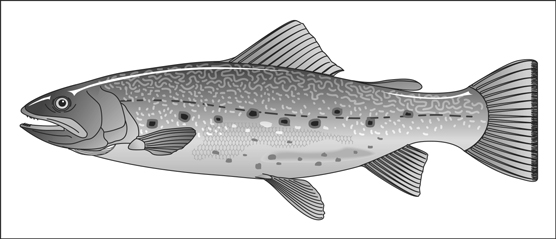 The brook trout is universally admired for its gorgeous coloring.
The brook trout is universally admired for its gorgeous coloring.The cutthroat: Yellowstone beauty
You may think of the cutthroat — which is really a cousin to the rainbow — as the Rocky Mountain version of the brook trout because in many undisturbed waters, just like the brookie, the cutthroat is the native fish. After ranching, logging, and the introduction of other gamefish takes place, the cutthroat often retreats to unpressured headwaters. The cutthroat is the native trout in the drainage of the Yellowstone River, where it is protected by a complete no-kill policy in all of the flowing water in Yellowstone Park. To fish them at the outlet of Yellowstone Lake is one of the great angling experiences in North America.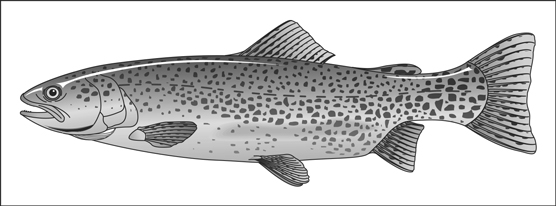 The cutthroat trout is most easily identified by red and orange slashes around the lower jaw and gills.
The cutthroat trout is most easily identified by red and orange slashes around the lower jaw and gills.Lake trout: Big macks
The lake trout (or laker) is the largest char. Unlike all the other trout, the laker spawns in lakes, not streams. As shown, the laker, similar to the brook trout, is heavily spotted. It has a forked tail (in contrast to the square tail of the brook trout). The lake trout requires colder water than any other freshwater gamefish, optimally about 50 degrees F, and it will die at 65 degrees F.Right after ice-out in the spring and right before spawning in the autumn, you may be able to take lakers in shallow water. But during the rest of the season, you have to fish deeper, often trolling using downriggers.
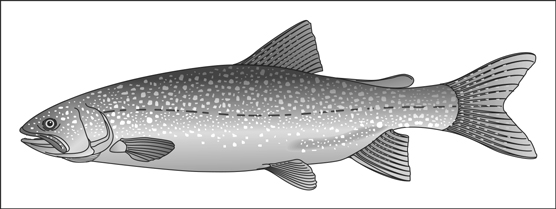 The lake trout looks like a giant brook trout with a forked tail.
The lake trout looks like a giant brook trout with a forked tail.Pacific salmon: Not just in the Pacific anymore
Pacific salmon come upstream to spawn just as Atlantic salmon do. The Pacific salmon’s flesh is pink, just like the flesh of an Atlantic. They even taste the same. But the six species of Pacific salmon are completely different animals than the Atlantic salmon, which is the only true salmon. (The Pacifics are the much larger, mostly ocean-going cousins of the rainbow trout.)The home range of Pacific salmon runs from Northern California up to Alaska and over to Siberia. Some years ago, Pacific salmon were introduced into the Great Lakes to help control the spread of the alewife herring. The alewives were so plentiful and the salmon fed so well on them that the Great Lakes now hold the greatest fishery for both the coho and chinook sportfisherman. In the Great Lakes, Pacific salmon are a favorite among trollers. This method of taking fish, of course, requires a hefty boat and expensive gear. Shallow-water and stream anglers have the most luck when the fish gather at stream mouths and within the streams themselves during their spawning migrations. Fishing when the salmon are still bright, or fresh from the ocean or lake, can be great sport with these brawny, athletic fish. As with many saltwater fish or as with fish that spend a good amount of time in saltwater, the chinook and coho like flashy, bright-colored lures that imitate the smelt and alewives they feed on.
The figure shows the coho and chinook salmon. The usually smaller coho has black spots only on the upper part of its tail, although the chinook’s tail is spotted on both top and bottom. The chinook’s dorsal fin is spotted; the coho’s isn’t. The gum in the lower jaw of the coho is grayish, but the same gum in the chinook is black.
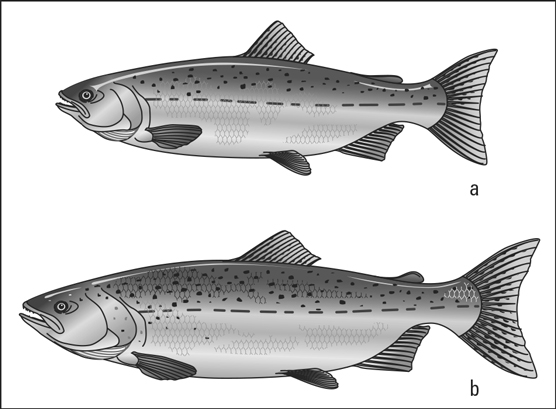 The coho (a) and chinook (b) salmon present fun big-water challenges.
The coho (a) and chinook (b) salmon present fun big-water challenges.Atlantic salmon: The leaper
The Atlantic salmon, through no fault of its own, is regarded by many as the aristocrat of fishes. Perhaps it has this reputation because you usually have to be an aristocrat to be able to afford a few days on one of the choice salmon rivers. You are generally required to fish for Atlantic salmon with a fly rod; and on many rivers, one also has to hire a guide.Known for its acrobatic jumps, the Atlantic salmon is a cousin to the brown trout but spends most of its time at sea (although a salmon’s infancy is passed in a river, and it is to that river that it returns to spawn). The Atlantic salmon (shown) does not die after spawning once, so you may return a salmon to the stream after catching it and be confident that it may well return to spawn and fight again.
Like the Pacific salmon, Atlantic salmon exist in inland bodies of water, too. Known as landlocked salmon, these fish are just like their more-traveled siblings but are a bit smaller. Although many landlocked salmon spend their lives in rivers, some stay in lakes year-round, usually staying in the deepest, coolest water. Wherever they’re found, anglers love to pursue Atlantic salmon for a chance to see their great leaps.
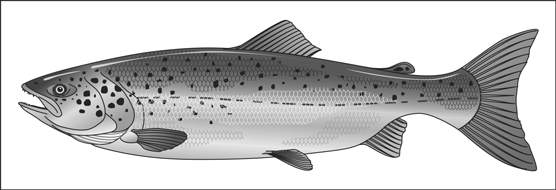 The Atlantic salmon is prized for both food and sport.
The Atlantic salmon is prized for both food and sport.

